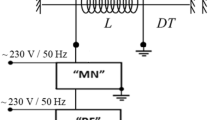Abstract
In order to maximize the gain coefficient of a CO2-N2-He gasdynamic laser, a total optimization of the stagnation parameters, the concentration coefficient, and the parameters which determine the shape of the nozzle (assuming a quasi-one-dimensional flow model) was carried out. The dependence of the optimized parameters on the limitations imposed by the stagnation temperature of the flow and the critical cross section have been determined.
Similar content being viewed by others

Literature cited
N. G. Basov, V. G. Mikhailov, A. N. Oraevskii, and V. A. Shcheglov, “The attainment of an inverted population of molecules in a supersonic shock tube with a Laval nozzle,” Zh. Tekh. Fiz.,38, No. 12 (1968).
J. D. Anderson, “Time-dependent analysis of population inversions in an expanding gas,” Phys. Fluids,131, No. 8 (1970).
J. D. Anderson, R. L. Humphrey, J. S. Vamos, R. J. Plummer, and R. E. Jensen, “Population inversions in an expanding gas: theory and experiment,” Phys. Fluids,14, No. 12 (1971).
J. D. Anderson and E. L. Harris, “Modern advances in the physics of gasdynamic lasers,” AIAA Paper, No. 143 (1972).
R. Capiaux, “Effect laser dans l'ecoulement d'un melange gazeux (CO2-N2 et H2O),” Compt. Rend. Acad. Sci., Ser. A and B,271, No. 15 (1970).
J. Tulip and H. Seguin, “Gasdynamic CO2 laser pumped by combustion of hydrocarbons,” J. Appl. Phys.,42, No. 9 (1971).
N. A. Generalov, G. I. Kozlov, and I. K. Selezneva, /ldThe inverted population of the CO2 molecule in a rapidly expanding gas stream,” Zh. Prikl. Mekhan. Tekh. Fiz., No. 5 (1971).
N. A. Generalov, G. I. Kozlov, and I. K. Selezneva, “Calculation of the parameters of a gasdynamic laser,” Zh. Prikl. Mekhan. Tekh. Fiz., No. 5 (1972).
S. Munjee, “Numerical analysis of a gasdynamic laser mixture,” Phys. Fluids,15, No. 3 (1972).
B. F. Gordetz, A. I. Osipov, E. V. Stupochenko, and L. A. Shelepin, “Oscillational relaxation in gases and molecular lasers,” Usp. Fiz. Nauk,108, No. 4 (1972).
M. Thomas-Andrand, A. Carrega, O. Leuchter, and J. P. Taran, “Laser themique a haute pression avec rechauffage par compression,” Rech. Aerospat, No. 6 (1972).
A. S. Biryukov and B. F. Gordetz, “The kinetic relaxation equations for rotational energy in polyatomic gas mixtures,” Zh. Prikl. Mekhan. Tekh. Fiz., No. 6 (1972).
R. L. Taylor, S. Bitterman, “Survey of vibrational relaxation data for processes important in the CO2-N2 laser system,” Rev. Mod. Phys.,41, No. 1 (1969).
W. A. Rosser and E. T. Gerry, “De-excitation of vibrationally excited CO2 (v 3) by collisions with He, O2, and H2,” J. Chem. Phys.,51, No. 5 (1969).
S. S. Penner, Quantitative Molecular Spectroscopy and Gas Emissivities, Addison-Wesley (1959).
V. P. Techinskii, “Potential gas lasers,” Usp. Fiz. Nauk,91, No. 3 (1967).
R. Ely and T. K. McCubbin, Jr., “The temperature dependence of the self-broadened half-width of the P-20 line in the 001–100 band of CO2,” Appl. Optics,9, No. 5 (1970).
V. V. Danielov, E. P. Kruglyakov, and E. V. Shunko, “Measurement of the transition probability P(20) (00 °1–10 °0) and the collisional broadening for collisions with CO2, N2, and He,” Zh. Prikl. Mekhan. Tekh. Fiz., No. 6 (1972).
Author information
Authors and Affiliations
Additional information
Translated from Zhurnal Prikladnoi Mekhaniki i Tekhnicheskoi Fiziki, No. 5, pp. 3–8, September–October, 1974.
Rights and permissions
About this article
Cite this article
Zharkov, V.D., Lapushonok, L.Y. & Chebikin, N.N. Optimization of the parameters of a CO2 gasdynamic laser. J Appl Mech Tech Phys 15, 585–589 (1974). https://doi.org/10.1007/BF00851512
Received:
Issue Date:
DOI: https://doi.org/10.1007/BF00851512


